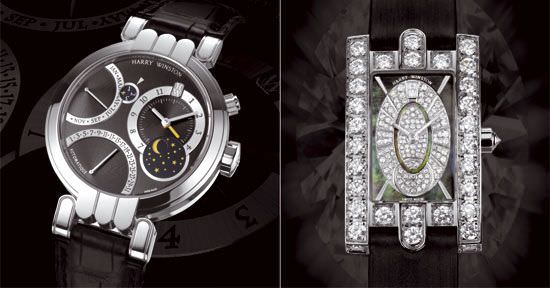
Reinvent the automatic movement? Since Perrelet (or Sarton or even others depending on the historians who are still squabbling about this subject), no one has found anything better, and more logical, than the circular moving body of a mass or a ring to wind a watch from the movements of the wearer.
But in today’s frenzy of watchmaking innovation, all the traditional aspects of the mechanical timepiece are being revisited, sometimes transformed, and even, rarely, surpassed.
The Glissière
So, the Glissière tourbillon automatic watch from Harry Winston proposes a new way to automatically wind a movement: the motion is linear rather than circular. (A way explored as well by the V4 that TAG Heuer will release probably next year.) Directly inspired from the sliding pistons of steam engines, the Glissière has, on the dial side, two platinum carriages guided by two rails that flank the gear trains, a bridge with a cut-out pattern of the HW monogram, and a flying tourbillon, all positioned to evoke the wheels and the connecting rods of a locomotive. This linear disposition is highlighted by the power reserve indicator, driven by a transmission with conic pinions and endless screws, that are displayed also via a carriage travelling along a slide.
However, the movement generated by these two platinum pins easily sliding on their rails is not sufficient to fully wind the barrel spring. Thus, they are coupled, on the back, by two other systems of automatic winding, also very original, composed of platinum pieces in the shape of fans, that rise and descend around an axis. In total, this surprising device has an excellent winding ability, requiring about four hours to completely arm the barrel spring, which offers a working reserve of more than 90 hours.

The TOURBILLON GLISSIèRE
Unusual angles
On the back of the watch is another original system, that of the time setting and winding that is carried out by two distinct rams directly connected to the shaft of the barrel and the under-dial work.
This device allows a total disengagement from the original case, which has been designed ‘around the movement’. Inspired by the case of the Avenue Collection by Harry Winston, it has nonetheless been greatly modified, with its central arch situated on its width. (The dimensions of the case are 49 mm x 47 mm.) What really differentiates this watch, however, are the lateral openings in the upper and lower part of the middle case. Through these openings can be admired, from an unusual angle, the complex mechanical workings of the Glissière, which has been developed for the brand by Christophe Claret.
The finishing of the piece is up to its exclusivity, with the tourbillon’s counter-pivot set with a diamond, its decorated and galvanized black gold bridges, its galvanized black gold plate decorated with circular graining, its rhodium-plated gears and barrel, its hand chamfering and polishing, as are the ratchets and the right-armed gears, as well as the hand polished and chamfered screws.
‘A work of mechanical art’, this locomotive is realized in white or pink gold (25 of each version), as well as a unique piece in white gold set with 216 brilliant cut diamonds and 180 baguette cut diamonds, for a total of 17 carats. Harry Winston demonstrates once again that, in spite of its diamond genes, the brand intends to continue its grand watchmaking creativity. This will be doubly the case with the Opus VII to be unveiled at BaselWorld.
The Excenter and the Avenue, 18 years later
Harry Winston earned its well-deserved haute horlogère identity with its first watch, the Excenter Perpetual Calendar presented in 1989. ‘Specializing’ in the retrograde display, popularized in part by the brand, Harry Winston has unceasingly followed this direction. Eighteen years after its first timepiece, the brand is now introducing a new Excenter Perpetual Calendar in a wider white gold case (41 mm) with an uncluttered anthracite or silvered dial with great readability, presenting retrograde perpetual calendar indications (day, month) as well as lunar phases and leap years in the form of disc displays that partially ‘eclipse’ the hours and the months.

The EXCENTER PERPETUAL CALENDAR and the NEW AVENUE
Driven by an automatic GP movement, it also has a second time zone, adjustable with the crown and indicated by a coloured hand.
In the purely jewellery and feminine domain, Harry Winston is introducing the second generation of its Avenue Collection, originally launched also in 1989. Still as Art Deco in design, it has, however, been somewhat ‘softened’ by a central oval, covered entirely in diamond pavé, as expected, that stands out from the mother-of-pearl background. With its imposing 20 VVS diamonds, it weighs a total of 4.5 carats.
Source: Europa Star April-May 2007 Magazine Issue





